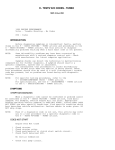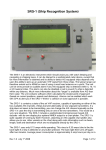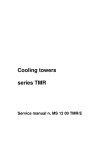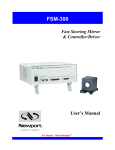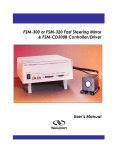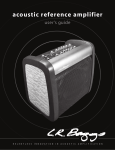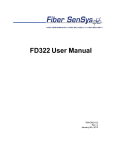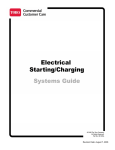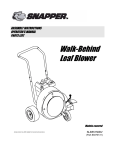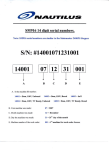Download Rotating Electric Troubleshooting Guide
Transcript
Charging & Starting System Testing Overview Rotating Electrical Troubleshooting Guide Key components to be tested before removing the starter motor Check connections and cables. Check drive belt condition, tension, automatic belt tensioner. Battery and connections Relay Belt Test the battery: right group size, state of charge, load test. Check operation of dash light indicator or dash voltmeter. Solenoid Battery cables Check for excessive parasitic draw. Check charging voltage and amp output. Battery Switches Identify and understand the key components to the starting and charging system. Need Assistance? Alternator Tech Support: 800-854-0076 Email: [email protected] Monday thru Friday 8AM – 8PM EST Saturday 8AM – 4:30PM EST Starter Motor Remy International, Inc. 600 Corporation Drive Pendleton, IN 46064 USA remyinc.com ©2012 Remy International. Inc. I5-121 Rotating Electrical Troubleshooting Guide Before you start Each page contains information and instructions that are important in assisting with the repair of your starting and charging system. Our technical assistance team at Remy are ASE certified and have available the latest wiring schematics and technical information. Due to the electrical complexities of today’s modern vehicles, it is important to determine why the unit failed. This manual will be most helpful in correctly finding the root cause of the difficulty, the first time. For Technical Assistance At Remy, it is our goal to provide you with a product that has passed the most severe and stringent tests in the industry. To insure that the starter motor and/or alternator perform to your complete satisfaction, we have taken the necessary steps to provide you the guidelines to achieve that objective. 1-800-854-0076 Mon - Fri: 8AM – 8PM EST Sat: 8AM – 4:30PM EST OEM Quality Alternators and Starters World Class Quality and Engineering Our vast engineering experience and manufacturing capabilities are carried over to our aftermarket products, providing the professional installer with the highest industry quality in fit, form, and function. Every unit must pass a stringent computerized load test that monitors key functions and parameters to simulate the actual demands of “real life” driving conditions. Remy differentiates itself from aftermarket competitors through in-house engineering and global manufacturing capabilities. World-Class manufacturing processes incorporating ISO, Six-Sigma and Lean principles insure each unit is produced to the highest possible standards. Notes Contents Electrical Essentials 1 2 Starter Motor 11 Belts, belt tensioner .................................... 2 Cranking circuit components .............................11 Battery ........................................................2 Aftermarket vs OE .............................................11 Battery, cables, connections .......................3 Starters: Where to begin? ..................................12 Excessive resistance & OHM’s Law ...........4 Does starter require a shim(s)?.....................13 -14 Connections .......................................................15 Alternator5 Cranking voltage at 2 locations ..........................15 Alternators: Where to begin?.......................5 Does starter have a good ground? ....................15 The Do’s & Don’ts .......................................6 Amp draw specs ................................................16 OE vs Aftermarket ......................................6 Analyze cranking voltage & amp draw ...............16 Amperage test ............................................7 Weak battery? Battery too small? ......................17 Alternator tests ...........................................7 Testing for excessive resistance (+) side ...........17 Not charging? Excessive resistance? .........8 Pinpoint tests on (+) side ...................................18 External voltage regulator test ....................9 Testing for excessive resistance (–) side ...........19 Causes of & testing for AC Ripple ..............10 Pinpoint tests on (–) side ...................................20 Overview .............................................. back cover Tech Support: 800-854-0076 Belts 2 The alternator is only as good as the belt. With the engine running, if dash indicator light stays on or flashes erratically, check the following: Are the belts: 1.Can pulley or fan be turned by hand due to loose or glazed belt? Belt will slip resulting in low output; dash light may stay on or flicker. • Oil soaked? 2.Is the belt cracked or contaminated with oil, ATF, coolant, etc? 3.Check for excessive noise from alternator. Could be a loose, worn belt, or pulleys not aligned. • Glazed/shiny? • Correct tension? • Cracked? • Misaligned? • Squealing? Belt Tensioner Automatic belt tensioners and idler pulleys do fail. Belt tensioner: Is the spring tension too tight? Too loose? Belt stretched? Check gauge on tensioner. Battery The battery is the heart of the system. Starter motor “draws” power from the battery. Rotating Electrical Troubleshooting Guide Alternator “generates” electric current to replace power lost and supply vehicle electrical system. Battery Testing 3 There are two key tests to determine condition of battery. Battery condition: State of charge test The battery voltage must be at least 12.4 volts before load test. Corrosion 12.6 v = 100% 12.4 v = 75% 12.2 v = 50% 12.0 v = 25% 11.8 v = 0% State of Charge State of Charge State of Charge State of Charge State of Charge Crack Electrolyte 1. Plates covered with water? 3. Top of battery clean? Load test Load test simulates the electrical demands placed on the battery. 2. Is battery secure in tray? 4. Correct size for vehicle? If load tester is not available, have your alternator/battery supplier test the battery. Battery Cables Cables connect your alternator and starter to the battery. Lower gauge number allows for greater amperage flow. Which cable will carry more power to the battery? Carefully inspect cables for: 2 GA. 1. Signs of cracked insulation. 2. Too long or short. While attempting to crank engine, do battery cables feel warm to the touch? If warm to the touch, cable gauge may be too small. 8 GA. ✔ ✘ There are some cables sold with thick insulation and very little copper. Look for gauge size printed on cable insulation. Caution! ✘ Tech Support: 800-854-0076 Connections 4 Critically important. Often overlooked, battery terminal ends and all cable connections are extremely vital Temporary ends can dramatically shorten life of an alternator or starter. How? Temporary ends Bare strands of copper wire under steel plates, bolted to lead terminal ends, and exposed to humidity equal corrosion. •Apply correct terminal protection product. Top post •Far better to use molded/crimped style terminals. •It is important that NO bare copper wire is exposed to the environment. Clean connections? Side terminal Excessive Resistance The starter and alternator are only as good as the connections. Until you completely eliminate excessive resistance, your starter and alternator will not function properly. All connections should be metal to metal, clean and tight. 4 possibilities for resistance PRESSURE E I R N LO TA RE TF Ohms NC CUR Amps E Volts W RES IS Rotating Electrical Troubleshooting Guide Alternators: Where to Begin 5 Symptoms Possible Cause Action Needed No output from alternator •Drive belt broken or loose • Replace or tighten belt. Dashboard indicator light illuminates when key on, engine off. •Voltage not present at alternator B+ terminal • Check fusible links and wire going to B+ terminal. Dash board charging indicator does not light while key on, engine off. •Blown fuse or fusible link • Check and replace fuses as needed. •Light bulb burned out • Replace charging indicator light bulb. •Corroded or loose connections • Clean and tighten connections and perform voltage drop test. Battery condition good Low voltage output from alternator •No voltage signal to field through regulator plug •Drive belt slipping •Belt tensioner weak • Check regulator plug for corrosion or melting. Replace pigtail if necessary. • Use test gauge on belt to determine if replacement is needed. • Check tensioner alignment marks for weakness. •Cables corroded •Improper body ground Lights dim at idle while all accessories are off. •Drive belt slipping or tensioner is weak •Improper engine rpm’s at idle •Weak or defective battery • Clean and tighten connections and perform volt drop test. • Clean and tighten body ground. • Check belt and tensioner for excessive wear. • Refer to manufacturer’s specifications and repair if needed. • Test battery and replace as needed. Tech Support: 800-854-0076 B+ Terminal 6 Is battery voltage available at B+ terminal? Insulator 1. Connection must be clean and tight at B+ terminal. 2. Do not over tighten and crack insulator. 3. Be careful not to strip threads. 4. Does wire from B+ terminal bolt connect to a fusible link at starter solenoid? If so, make sure the fusible link is clean and tight. B+ terminal 5. All brackets to alternator connections should be clean metal-to-metal. Note: Before removing alternator, make sure battery (–) cable is disconnected. Removing either battery cable with engine running will create a damaging voltage spike. This was never a valid test for an alternator. Voltage spikes and arcing are poison to the electrical system. Alternator and system management computers may be damaged and or destroyed. OE vs Aftermarket Why doesn’t the replacement alternator last as long as the OE unit? Answer: Poor connections and excessive voltage drop Clean and tight connections insure electrical system functions as designed. Metal chassis Rotating Electrical Troubleshooting Guide Engine block Amperage Test 7 Testing the alternator for AMP capacity. 1. Place AMP inductive clamp on heavy gauge wire(s) coming from back half of alternator. AMPS VOLTS 90 13.0 2. With engine at normal operating temp, and at high RPM’s, load engine down by turning up the load on the carbon pile tester amperage reading. 3. The unit is good if AMP output is within 80–100% rated output. 4. If AMP reading is low, it could be a bad alternator or excessive resistance may be in the charging circuit. Note: Battery must be fully charged Alternator Tests Voltage test. This procedure does not apply to computer controlled charging systems. 1. With voltmeter connected to battery, key and engine off, record “base” voltage reading: ________ volts. Note: Battery should have minimum of 12.4 volts. 2. Start engine and bring to normal operating temperature. 3. With engine at 1500 to 2000 RPM, turn on all electrical loads (lights, blower fan, A/C, etc.) record volts: _________volts. 4. Charging voltage should be at least 0.5 volt above base voltage reading. If not, excessive resistance could be present. Tech Support: 800-854-0076 Voltage at the Alternator 8 Check charging voltage at alternator (illustration to left) and then again at battery (below test). This test will determine if there is a problem between the alternator and battery. With engine running, 1500 to 2000 rpm, loads on: 1. Measure charging voltage at alternator, and record: _______volts. 2. Measure open circuit voltage at battery, and record: _______volts. Engine block 3. If the difference is greater than 1 volt, there is a problem. Voltage Not charging? Looking for excessive resistance on the (+) side: •Voltmeter (+) test lead to alternator B+ terminal •Voltmeter (–) test lead to battery (+) post •Set voltmeter on lowest DC volt scale •With engine running at 1500 to 2000 rpm, all loads on, measure and record voltage drop________. Note: Should not exceed 0.5 volt drop. If voltage drop exceeds 0.5 volt, check for: • Corrosion • Loose connections • Frayed strands of wire • Battery cable gauge too small Rotating Electrical Troubleshooting Guide Still Not Charging? 9 There is resistance in the charging circuit somewhere. Couldn’t find the excessive resistance on the (+) side? Let’s check the (–) side: • Voltmeter (+) test lead to battery (–) post .03 • Voltmeter (–) test lead to alternator case • Set voltmeter on lowest DC volt scale. • With engine running at 1500 to 2000 rpm, all loads on, measure and record voltage drop:_______. Note: Should not exceed 0.3 volt drop If voltage drop exceeds 0.3 volt, check for: • Corrosion • Battery cable gauge too small • Loose connections • Frayed strands of wire External Voltage Regulator All alternators with external voltage regulators. Regulator must have a good ground ( for alternator to function. ) in order To determine if external voltage regulator is properly grounded, follow these simple steps: 1. Engine running, no loads on 2. DVOM (+) lead to the regulator metal housing 3. DVOM (–) lead to battery (–) post 4. Set DVOM on lowest DC volt scale. 5. If reading is 0.1 volt (or 100mv) DC or above, the regulator does not have a good ground. 6. Clean and retest for a good ground. External voltage regulator Tech Support: 800-854-0076 AC Ripple Voltage 10 What is AC voltage ripple and how does it cause problems? AC Voltage ripple is alternating current riding on top of DC current • Causes poor voltage source to modules: ABS, ECU, PCM, etc. • Modules need quality DC voltage source to make accurate decisions, on the (+) side and (–) side. • Changing amplitude of AC voltage ripple on top of linear DC voltage can cause module to lose its place in the engine run program. Corrosion acts like a semi-conductor causing DC voltage to fluctuate • This results in: • Erratic spark timing • Missing fuel injector pulses • Significant driveability problems Excessive AC ripple caused by: • Alternator: bad diodes or stator • Corrosion at the battery or any connection • Sulfated battery AC Ripple Tests What is the most accurate tester to measure for AC ripple? Many have used an “Averaging” voltmeter. Some have graduated to an “RMS” voltmeter. However, due to changes in alternator design technology, such as amount of current produced, rotor shaft RPM, stator windings, it is far more accurate to use a Lab Scope. Usage of a voltmeter, due to the slow refresh rate, is not an accurate test. A scope will provide an actual “footprint” of the AC Ripple, not just a voltage number. Rotating Electrical Troubleshooting Guide Lab Scope Cranking Circuit 11 The following components have a profound effect on the starter and its ability to crank the engine: • Battery • Battery cables • Relay/solenoid • Neutral safety switch • Alarm system • Ignition switch Connections Why doesn’t the aftermarket starter motor last as long as OE? Answer: Poor connections and excessive voltage drop Potential Problems Note: the starter motor is only as good as each one of these connections. Metal chassis Engine block Tech Support: 800-854-0076 Starters: Where to Begin 12 Symptoms Possible Cause Action Needed •Dead battery •Check battery state-of-charge. •Loose connections •Clean and tighten connections. •Defective solenoid/mag switch, relay, neutral start switch or clutch switch •Check and replace as needed. •Defective fusible link Engine will not crank. Engine cranks too slow. Starter keeps running. Starter spins, but engine will not crank. Starter does not engage or disengage properly. •Defective ignition switch •Replace fusible link. •Check switch operation, replace as needed. •Check engine. •Mechanical problem in engine •Problem in vehicle anti-theft system •Check service manual for system tests. •Weak battery •Check battery state of charge. •Defective starter motor •Test starter. •Mechanical problem with engine •Diagnose engine problem and repair. •Damaged pinion or ring gear •Check gears for wear or damage. •Defective ignition switch or control circuit •Check switch and circuit components. •Defective drive clutch •Defective starting motor •Rotate pinion by hand, it should not go both ways. •Defective solenoid/mag switch •Bench test starter, if passes check external switches / control circuit. •Loose or corroded connections •Defective starter or magnetic switch •Damaged or worn pinion gear or ring gear Rotating Electrical Troubleshooting Guide •Clean and tighten connections. •Test starter, and Magnetic switch. •Test motor and verify drive extension. •Check teeth on both drive and ring gear. Starter Shims 13 Noisy, grinding starter “To shim or not to shim”. In order for starter to operate efficiently and quietly, shimming may be required, even if shims were not used on original installation. On some applications, you will have to either add shim(s) or remove shim(s) to achieve correct “gap” (clearance). Proper clearance between starter drive pinion gear and flywheel ring gear is critical for correct operation of starter (See Fig. 1). Fig. 1 To achieve correct gap between ring gear and starter drive, usage of one or more shims may be required on certain GM engines (See Fig. 2). Fig. 2 Does your starter motor require a shim(s)? Use your ears to listen for problem sounds. Do you hear a high pitched whine or clanging sound while cranking, before engine starts? Gap too loose? Problem: excessive clearance Starter must be shimmed closer (into) ring gear to reduce gap (clearance). Remove any existing shims. Start with one .015” shim cut in half on outboard bolt only (the bolt on outside of starter motor away from engine) See Fig. 3. Engine Block Half shim GAP This will move starter closer into the ring gear. Outboard bolt Fig. 3 Tech Support: 800-854-0076 Starter Shims 14 Does your starter motor require a shim(s)? Gap too tight? Use your ears to listen for problem sounds. Engine Block Do you hear a high pitched whine after engine starts, as key is being released? Problem: not enough clearance. Starter must be shimmed away from ring gear to increase gap (clearance). Shim GAP Install one .015” shim across both bolt holes to increase gap (See Fig. 4) Fig. 4 OR Install one .015” shim cut in half or a substitute shim on inboard bolt only; the bolt on inside of starter motor closest to engine (See Fig. 5). Outboard bolt Engine Block Usage of one shim on inboard bolt only, will provide greater clearance. Half shim Note: Do not use more than 3 shims on either side. GAP When installing replacement starter motor DO NOT use an impact gun or breaker bar to tighten bolts! Nose cones are made of aluminum and are very easy to distort or crack by over tightening. Fig. 5 Inboard bolt • Always reinstall any existing heat shields and rear support brackets. • Make sure all connections at solenoid are clean and tight. • Add or remove shims one at a time to avoid damage. Providing the proper gap will award you with a quiet starter and a longer life Rotating Electrical Troubleshooting Guide Cables and Connections Too hot to handle? 15 Check connections While cranking, if either battery cable feels hot, gauge of cable may be too small or too long or possibly a short within the starter. When replacing battery cables, always use shortest, heaviest gauge cables possible. Right Terminal end is pressed down completely over battery post. Wrong Terminal end is not properly seated. Cranking Voltage At two locations? While Cranking: 10.7 volts – 9.2 volts 1.5 volts If the difference is greater than 1 volt, excessive resistance is present. Excessive resistance could be on the + or – side or the side of the cranking circuit. To prevent engine from starting, some vehicles may not start with (WOT) See manufacturer’s service manual. PROBLEM! Good Ground? The starter motor is grounded to engine block. Engine must have a good ground through the battery cable back to battery (–) terminal in order to crank. •To prevent engine from starting, some vehicles may not start with (WOT). See manufacturer’s service manual •With voltmeter test leads as shown, measure and record voltage while cranking: ________ volt. •If voltage exceeds 0.2 volt, there is a poor ground in (–) cable or connections. Tech Support: 800-854-0076 Amp Draw Specs 16 “Approximate” amp draw specifications. Engine Size Amp Draw Cubic Inches Liters 100 to 200 1.6 to 3.2 100 to 200 200 to 350 3.2 to 5.6 125 to 250 350 to 500 5.6 to 8.0 150 to 300 There is no fixed amperage draw for every engine Why? • Engine size • Compression •Weight (viscosity) of oil • Mechanical condition of engine • Carbon buildup • Design of starter motor • High torque, low torque, gear reduction, etc. All have an impact on amperage draw. Analyze Cranking Voltage & Amperage Problem: high mechanical resistance, resulting in high amp draw. Amps High Volts Low • Carbon build up on top of pistons • Wrong weight oil • Cable that is shorted to ground • Bad starter Possible causes: Problem: high electrical resistance, resulting in low amp draw. Volts Normal Amps Low Possible causes: • Loose connections • Frayed cables, etc. • Corrosion • Cable gauge too small resulting in high resistance • Binding engine Problem: Amps High A weak or undersized battery resulting in: • Low cranking voltage • Destroyed starter • Slower spinning armature causing starter to draw excessive amps Rotating Electrical Troubleshooting Guide Volts Low Weak Battery? 17 A weak or undersized battery will cause high amp draw. Weak battery • Voltage drops to 9.5 volts while cranking • Example: starter motor needs 2095 watts • Volts x AMPS = watts • How many amps will this starter motor now need in order to crank? • 2095 watts Weak battery 9.5 volts = 220 AMPS Strong battery • Voltage drops to 11.2 volts while cranking • Example: starter motor needs 2095 watts • How many AMPS will this starter motor now need in order to crank? • 2095 watts 11.2 volts = 187 AMPS Strong battery Testing (+) Side Testing for excessive resistance on the (+) side. 1. Must have fully charged battery 2. To prevent engine from starting, some vehicles may not start with (WOT). See manufacturer’s service manual. 3. Set DVOM on lowest volt scale. 4. DVOM (+) lead to battery (+) post 5. DVOM (–) lead to battery terminal stud on starter 6. While cranking engine over, record ________voltage drop (excessive resistance). 7. If voltage drop exceeds 0.5 volt, clean all connections between battery & starter. Metal chassis Engine block Tech Support: 800-854-0076 Positive Side (+) 18 Starter motor pinpoint tests on positive side. 1.Must have fully charged battery 2.To prevent engine from starting, some vehicles may not start with (WOT). See manufacturer’s service manual. 3.Set DVOM on 2 volt scale or lowest volt scale. 4.Engine at normal operating temp 5.The following pinpoint tests will show you exactly where the excessive voltage drop is located. ___________Maximum v/drop 0.00 ___________Maximum v/drop 0.20 ___________Maximum v/drop 0.20 ___________Maximum v/drop 0.20 Rotating Electrical Troubleshooting Guide Amperage 19 Amperage must flow in a complete circuit. Why test for excessive resistance on the (–) side? Ohm’s Law states: Amperage out, amperage in Bolted to engine block All amps that reach the starter motor, must return to battery (–) post. Excessive resistance could be anywhere within the (–) path. The starter motor is grounded through the nose housing to engine block. This connection must be clean and tight. Testing (–) Side Testing for excessive resistance on the (–) side. 1. Must have fully charged battery 2. To prevent engine from starting, some vehicles may not start with (WOT). See manufacturer’s service manual. 3. Set DVOM on lowest volt scale. 4. DVOM (+) lead to clean metal spot on starter 5. DVOM (–) lead to battery (–) terminal 6. While cranking engine over, record ________voltage drop (excessive resistance). 7. If voltage drop exceeds 0.3 volt, clean all connections between battery and starter. Tech Support: 800-854-0076 Negative Side (–) 20 Starter motor pinpoint tests on negative side. 1.Must have fully charged battery. 2.To prevent engine from starting, some vehicles may not start with (WOT). See manufacturer’s service manual. 3.Set DVOM on 2 volt scale or lowest volt scale. 4.Engine at normal operating temp. 5.The following pinpoint tests will show you exactly where the excessive voltage drop is located. Junction: solenoid or relay ___________Maximum v/drop 0.30 Rotating Electrical Troubleshooting Guide Starter terminal Engine block ___________Maximum v/drop 0.20 ___________Maximum v/drop 0.00 Before You Start Please read carefully for maximum results from this manual Each page contains information and instructions that are most important in assisting with the repair of your cranking and/or charging problem. Due to the electrical complexities of today’s modern vehicles, it is important to determine Why the previous unit failed. This manual and the implementation of the procedures described therein, will be most helpful in correctly finding the root cause of the difficulty, the first time. At Remy, it is our goal to provide you with a product that has passed the most severe and stringent tests in the industry. To insure that the starter motor and/or alternator perform to your complete satisfaction, we have taken the necessary steps to provide you the guide lines to achieve that objective. In addition, we have provided below our technical assistance contact information to further help you troubleshoot your cranking or charging problem. Our technical assistance team at Remy are ASE certified. They have available the latest wiring schematics and technical information. For Technical Assistance 1-800-854-0076 Mon - Fri: 7AM – 7PM CST Sat: 7AM – 3:30PM CST OEM Quality Alternators and Starters World Class Quality and Engineering Our vast engineering experience and manufacturing capabilities are carried over to our aftermarket products, providing the professional installer with the highest industry quality in fit, form, and function. Every unit must pass a stringent computerized load test that monitors key functions and parameters to simulate the actual demands of “real life” driving conditions. Remy differentiates itself from aftermarket competitors through in-house engineering and global manufacturing capabilities. World-Class manufacturing processes incorporating ISO, Six-Sigma and Lean principles insure each unit is produced to the highest possible standards. Notes Charging & Starting System Testing Overview Rotating Electrical Troubleshooting Guide Key components to be tested before removing the starter motor Check connections and cables. Check drive belt condition, tension, automatic belt tensioner. Battery and connections Relay Belt Test the battery: right group size, state of charge, load test. Check operation of dash light indicator or dash voltmeter. Solenoid Battery cables Check for excessive parasitic draw. Check charging voltage and amp output. Battery Switches Identify and understand the key components to the starting and charging system. Need Assistance? Alternator Tech Support: 800-854-0076 Email: [email protected] Monday thru Friday 8AM – 8PM EST Saturday 8AM – 4:30PM EST Starter Motor Remy International, Inc. 600 Corporation Drive Pendleton, IN 46064 USA remyinc.com ©2012 Remy International. Inc. I5-121
























